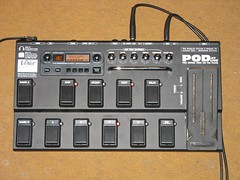Worked:
- I arrange my patches left to right (A-D) clean progressing to dirty.
- A = clean sound with a bit o delay
- B = Bluesy sound that is good for plucky parts and rhythm, some distortion. breaks up a bit when I hit it hard. This is my most versatile patch and it lives on the B switch for any bank. It's the run to home to mama patch.
- C = Power Chord patch. Over-driven, compressed and no delay. I like to have this serve a percussive role in the mix.
- D = lead patch. overdrive and delay. I have a chorus element ready to go but usually have it "off" by default. If I want it I can hit the mod switch.
The less I can think about tech the better when playing.
Did Not Work
- I left the patch list at home so I had to 'remember' what I'd come up with on the spot. doh!
- A couple of patches were way too loud despite my attempts to sync. I believe what happened is that they were consistent levels on my computer but I failed to sync the XT.
- I need to ensure that a patch I need for a song is not stuck on another bank set. I had one patch on 30D that I needed on my 31 series.
- Advice = Copy the patches to multiple banks so you can have a bank for each song. Don't worry about 'losing' some great patch. Save it on your computer and some reserve bank.


